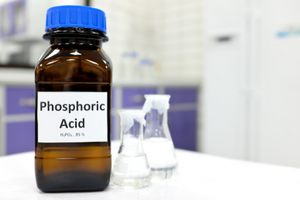In inorganic chemistry, there are many acids containing phosphorus. Phosphoric acid (V), also called orthophosphoric acid and having the structural formula H3PO4, is a characteristic compound with a very wide industrial application. But is it safe to use?

Where does phosphoric acid come from?
There are two basic methods for obtaining phosphoric acid. The first, the so-called wet method, makes use of calcium phosphate naturally present in rocks in the form of minerals such as apatites and phosphorites. When treated with sulphuric acid, they are transformed into easily filterable calcium sulphate and industrial quality phosphoric acid (V).
Optionally, food and chemical grade acid is also produced by isolating pure phosphorus in an electric arc furnace and then converting it to tetraphosphorus decatoxide. The compound is then treated with hot water, resulting in pure, high quality phosphoric acid (V).
Properties of phosphoric acid (V)
Pure phosphoric acid is a crystalline solid without colour or odour. Highly soluble in water, it forms a transparent solution which, in high concentrations, is highly caustic. Solutions in higher concentrations have a very low pH and are therefore ideal for acidification.
The compound has corrosive properties and reacts with active metals such as aluminium and iron, releasing hydrogen. In addition, it is hygroscopic, so it effectively absorbs water from its surroundings.
At 42.35°C, phosphoric acid crystals melt. The boiling point is 212°C at normal atmospheric pressure.

Fertilisers – the main application of phosphoric acid
Phosphoric acid (V) is used primarily in the manufacture of mineral fertilisers. These substances, which are used extensively in agriculture, are designed to provide crops with the ideal proportions of elements necessary for growth, particularly nitrogen, phosphorus and potassium. The key phosphate fertilisers are mainly superphosphates with a high level of bioavailability.
Unfortunately, the high consumption of phosphate fertilisers results in large quantities of phosphorus being released into the environment. This results in the eutrophication of water bodies, which further leads to a serious disturbance of the biological balance.
Other examples of the use of phosphoric acid
Up to 90% of the global production of phosphoric acid is used in the production of artificial fertilisers. The remainder is used primarily in the food industry. As food additive E338, phosphoric acid (V) acts as an acidity regulator and is present in many popular carbonated drinks – among others, it is responsible for the characteristic taste of Coca-Cola.
E338 is also an inhibitor of bacterial and mould growth, which increases the safety of food products (e.g. jams) and extends their shelf life. Phosphoric acid salts not only regulate acidity, but also modify milk proteins and are therefore used in the production of dairy products.
Other applications of phosphoric acid include:
- chemical and pharmaceutical industries,
- production of phosphate-based protective coatings which give metals anti-corrosion properties,
- dentistry and orthodontics (the compound is used to etch tooth surfaces),
- fuel cell production,
- sanitising dairy and brewery plants,
- removing rust from metal parts.
In addition, phosphoric acid salts are also used in laboratory work, in soap and detergent production and in water purification.
A wide range of products based on organophosphorus compounds, also derived from phosphoric acid (V), is available in the offer of the PCC Group. Available products such as phosphonates or phosphates can be found in the Product Portal Catalogue.

Is phosphoric acid dangerous?
There are limited amounts of phosphoric acid and its salts in the human body. They are responsible for the correct pH of body fluids, but also build nucleic acids and molecular energy carriers – ATP and ADP. The compound is also present in the teeth and bones.
On the other hand, excessive amounts of phosphoric acid (V) can be harmful to health. The main danger, of course, is contact with a highly concentrated solution of H3PO4. This highly caustic compound in contact with skin and mucous membranes causes chemical burns. Its consumption leads to severe irritation of the digestive system, vomiting, bloody diarrhoea, breathing difficulties and even convulsions and death.
Unfortunately, also as a food additive E338 in high doses has adverse health effects. According to scientists, too much phosphorus can lead to the development of kidney stones and osteoporosis. It also interferes with the absorption of many valuable minerals and causes enamel erosion on teeth.
- https://pubchem.ncbi.nlm.nih.gov/compound/Phosphoric-Acid
- https://www.britannica.com/science/phosphoric-acid
- https://www.chemie.de/lexikon/Phosphors%C3%A4ure.html